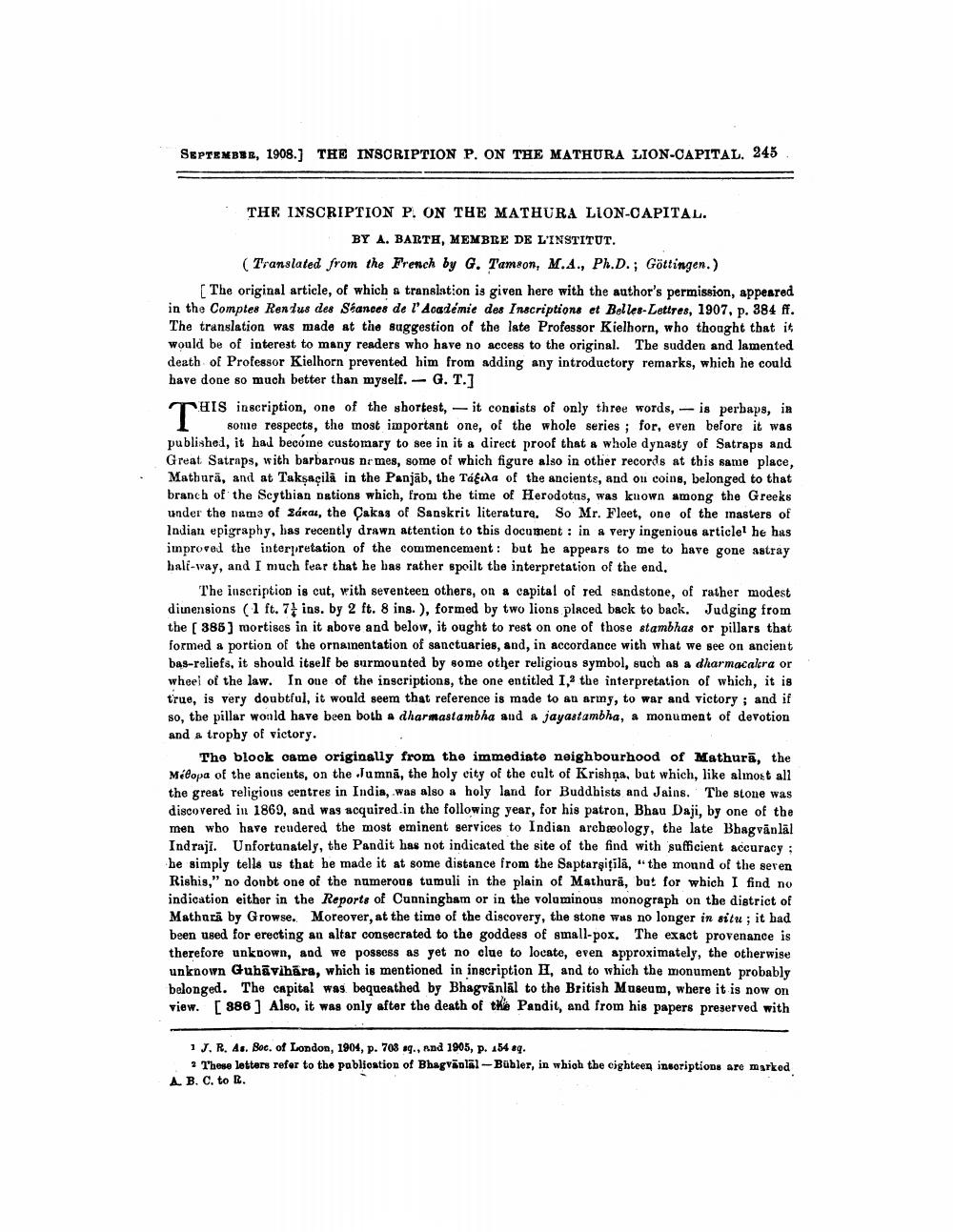________________
SEPTEMBER, 1908.] THE INSCRIPTION P. ON THE MATHURA LION-CAPITAL. 245
THE INSCRIPTION P. ON THE MATHURA LION-CAPITAL.
BY A. BARTH, MEMBRE DE L'INSTITUT. (Translated from the French by G. Tamson, M.A., Ph.D.; Göttingen.) [The original article, of which a translation is given here with the author's permission, appeared in the Comptes Rendus des Séances de l'Académie des Inscriptions et Belles-Lettres, 1907, p. 384 ff. The translation was made at the suggestion of the late Professor Kielhorn, who thought that it would be of interest to many readers who have no access to the original. The sudden and lamented death of Professor Kielhorn prevented him from adding any introductory remarks, which he could have done so much better than myself. - G.T.] THIS inscription, one of the shortest, - it consists of only three words,- is perbaps, in
some respects, the most important one, of the whole series ; for, even before it was published, it had become customary to see in it a direct proof that a whole dynasty of Satraps and Great Satraps, with barbarnus nrmes, some of which figure also in other records at this same place, Mathură, and at Takşaçila in the Panjāb, the Táfia of the ancients, and ou coins, belonged to that branch of the Scythian ngtions which, from the time of Herodotas, was known among the Greeks under the name of Saras, the Çakas of Sanskrit literature. So Mr. Fleet, one of the masters of Indian epigraphy, has recently drawn attention to this document: in a very ingenious articlel he has improved the interpretation of the commencement: but he appears to me to have gone astray hali-way, and I much fear that he bas rather spoilt the interpretation of the end.
The inscription is cut, with seventeen others, on a capital of red sandstone, of rather modest dinensions (1 ft. 7 ins. by 2 ft. 8 ins. ), formed by two lions placed back to back. Judging from the ( 886 ) mortises in it above and below, it ought to rest on one of those stambhas or pillars that formed a portion of the ornamentation of sanctuaries, and, in accordance with what we see on ancient bas-reliefs, it should itself be surmounted by some other religious symbol, such as a dharmacakra or wheel of the law. In one of the inscriptions, the one entitled 1,2 the interpretation of which, it is true, is very doubtful, it would seem that reference is made to an arıny, to war and victory; and if So, the pillar would have been both a dharmastambha and a jayastambha, a monument of devotion and a trophy of victory.
The block oame originally from the immediate neighbourhood of Mathurā, the Mélopa of the ancients, on the Jumnā, the holy city of the cult of Krishna, but which, like almost all the great religious centres in India, was also a holy land for Buddhists and Jains. The stone was discovered in 1869, and was acquired in the following year, for his patron, Bhau Daji, by one of the men who have rendered the most eminent services to Indian arcbæology, the late Bhagvanlal Indraji. Unfortunately, the Pandit has not indicated the site of the find with sufficient accuracy : he simply tells us that he made it at some distance from the Saptarsiţila, "the monnd of the seren Rishis," no donbt one of the numerous tumuli in the plain of Mathurā, but for which I find no indication either in the Reports of Cunningham or in the voluminous monograph on the district of Mathura by Growse. Moreover, at the time of the discovery, the stone was no longer in situ ; it had been used for erecting an altar consecrated to the goddess of small-pox. The exact provenance is therefore unknown, and we possess as yet no clue to locate, even approximately, the otherwise unknown Guhāvibāra, which is mentioned in inscription II, and to which the monument probably belonged. The capital was bequeathed by Bhagvānāl to the British Museum, where it is now on view. [886] Also, it was only after the death of the Pandit, and from his papers preserved with
1 J. R. As. Soc. of London, 1904, p. 708 sq., and 1905, p. 154 sq.
These letters refer to the pablioation of Bhagväpläl-Bübler, in which the cighteen insoriptions are markod A B. C, to R.




